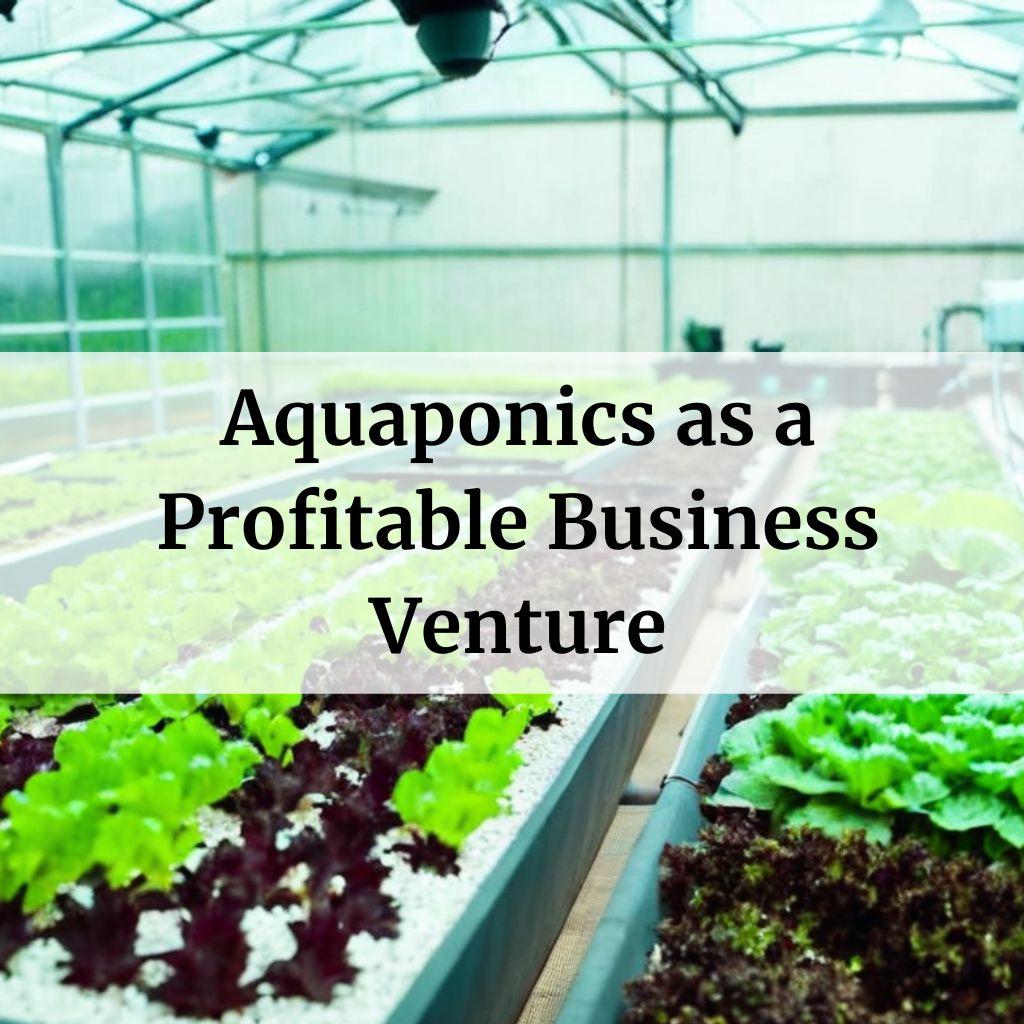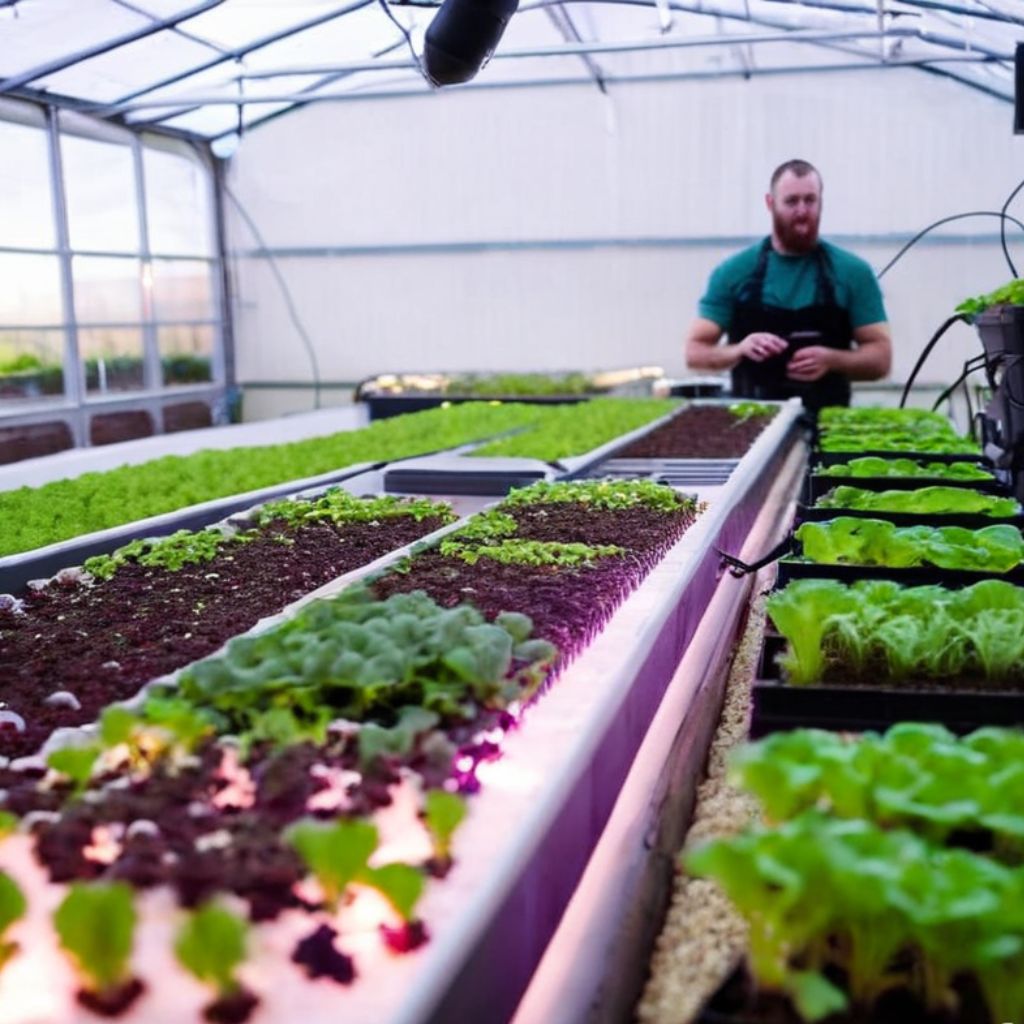
Aquaponics is a sustainable and innovative method of agriculture that combines aquaculture and hydroponics. It has gained popularity in recent years and offers potential for a profitable business venture. However, it is still considered a new method of food production, with only a few researchers and practitioners worldwide. In this article, we will explore the profitability and business aspects of aquaponics, including initial investment costs, ongoing operational expenses, diversification, and market research.
In this article
Can aquaponics be profitable?
Aquaponics can be a profitable business venture if done correctly and with a solid business plan and strategy. Here are some factors to consider when determining the profitability of an aquaponics operation:
- Scale: Larger-scale aquaponics setups are more likely to be profitable than smaller ones. For example, an acre of an aquaponics farm can generate up to $2 million in sales per year if optimized for high space utilization efficiency.
- Diversification: A commercial aquaponics operation is more likely to be profitable if it sells other products and services in addition to plants and fish. This could include offering consulting services, courses, or selling other agricultural products.
- Knowledge and Experience: Growers with more in-depth knowledge of aquaponics systems are more likely to have a profitable business. Consider attending workshops, courses, or receiving mentorship from experienced professionals in the field to improve your skills.
- Market Demand: The profitability of an aquaponics operation depends on the demand for its products in the local market. Conduct market research to ensure there is a sufficient demand for your crops and fish.
- Operational Costs: Consider the initial investment costs and ongoing operational expenses when determining the potential profits of an aquaponics system. These costs can vary depending on the size of the operation, the type of plants and fish being grown, and the location.
While aquaponics can offer significant returns, it is not an assuredly profitable industry. Only about 1/3 of growers in a study stated that their operation was profitable. However, it’s important to note that most operations in the study were still in the start-up phase, with an average time in business of about 4 years at the time of the study.
Let’s explore each aspect in more detail:
Larger-scale aquaponics setups
Larger-scale aquaponics setups are designed for commercial food production and can be more complex than small-scale systems. Here are some key features and considerations for larger-scale aquaponics setups:
- Commercial System Specifications: Larger-scale systems are designed to maximize production and profitability. For example, a small commercial system may produce 32,250 – 46,350 lettuce plants per year, along with 1,800 – 3,240 leafy green plants in the living filter bed.
- Modular Design: Many larger-scale systems use a modular design, allowing for easy expansion to meet growing demand. This also provides consistency in operations, efficiency, and training.
- Balance between Fish, Bacteria, and Plants: Achieving a good balance between fish, bacteria, and plants is essential for a successful and sustainable aquaponics system design. This balance can be more challenging to maintain in larger systems.
- Water Quality and Waste Management: Larger systems require careful monitoring of water quality and waste management to ensure the health of the fish and plants. This may involve the use of additional filtration systems and monitoring equipment.
- Labor and Efficiency: Larger-scale systems can be more labor-intensive to manage, but they also offer the potential for increased efficiency and profitability. Advanced, science-based designs can help reduce labor and increase overall system efficiency.
- Expansion and Diversification: One advantage of larger-scale systems is the ability to diversify production by adding different types of plants or fish. This can help mitigate risk and increase overall profitability.
- Research and Development: As aquaponics continues to evolve, ongoing research and development are essential for improving system design, water management, and overall sustainability.
- Training and Support: When investing in a larger-scale aquaponics system, it’s important to choose a supplier that offers comprehensive training, documentation, and ongoing support to ensure the success of your venture.
Diversification in Commercial Aquaponics Operation
Diversification is an important aspect of a commercial aquaponics operation. Here are some key points to consider:
- Types of Products: Commercial producers tend to sell more types of products than other stakeholders, suggesting that diversification of offerings may be key to profitability. This could include selling non-food products like materials and supplies, training, agritourism, and consulting.
- Risk Mitigation: Diversification can help mitigate risk by spreading out revenue streams and reducing dependence on a single crop or product.
- Expansion: Diversification can also help with expansion by allowing growers to add different types of plants or fish to their operation.
- Knowledge and Labor: Diversification of production requires higher levels of knowledge and labor demands. Growers should consider the additional costs and resources required to diversify their production.
- Market Demand: It’s important to consider market demand when diversifying production. Conduct market research to ensure there is a sufficient demand for the additional products being grown or sold.
- Profitability: Operations that diversify their revenue stream by selling non-food products tend to have higher gross sales revenue and profitability. However, it’s important to note that diversification always comes at a price, and growers should carefully consider the costs and benefits of diversifying their production.
Overall, diversification can be an effective strategy for commercial aquaponics operations to increase profitability and mitigate risk. However, growers should carefully consider the additional costs and resources required to diversify their production and ensure there is sufficient market demand for the additional products being grown or sold.
Business Plan and Strategy
Developing a solid business plan and strategy is crucial for the success of a commercial aquaponics operation. Here are some key steps to consider when creating a business plan:
- Executive Summary: This section should provide an overview of the business, including the mission statement, goals, and objectives.
- Company Overview: This section should provide a detailed description of the company, including its history, ownership structure, and legal structure.
- Industry Analysis: This section should provide an overview of the aquaponics industry, including market trends, competition, and regulatory issues.
- Customer Analysis: This section should identify the target market for the business, including demographics, psychographics, and buying behavior.
- Competitive Analysis: This section should analyze the strengths and weaknesses of the competition, including their products, pricing, and marketing strategies.
- Marketing Plan: This section should outline the marketing strategy for the business, including product positioning, pricing, promotion, and distribution.
- Operations Plan: This section should describe the day-to-day operations of the business, including production processes, staffing, and logistics.
- Management Team: This section should introduce the management team and their qualifications, including their experience in aquaponics and business management.
- Financial Plan: This section should provide a detailed financial analysis of the business, including revenue projections, expenses, and cash flow.
When creating a business plan, it’s important to consider factors such as scale, diversification, knowledge and experience, market demand, and operational costs. Additionally, aquaponics can be profitable when done correctly, but it’s important to note that profitability can vary depending on the size of the operation, the type of plants and fish being grown, and the location.
Workshops and Courses
There are many workshops and courses available for those interested in learning more about commercial aquaponics. Here are some recommended options:
- The Aquaponic Source Online Classes: The Flourish Farm Online Aquaponic Classes offer a comprehensive education on running a successful aquaponic farm business. The complete course includes all 12 online aquaponic classes, in-farm videos and PowerPoint presentations, resource downloads and business plan templates, and more.
- Aquaponics Courses at The Aquaponic Source: The Aquaponic Source offers a variety of courses, including Aquaponic Basics, Immersion Weekend, Aquaponic Greenhouse Design, and The Flourish Farm Course. They also offer custom aquaponics training tailored to fit your needs.
- Nelson and Pade Aquaponics Courses: Nelson and Pade offer a range of online courses, including Introduction to Aquaponics, Aquaponics Master Class, Aquaponics 101, and Commercial Aquaponics. They also offer a Greenhouses and Indoor Farming Online Course and The Science of Aquaponics Online Course.
- Chicago Botanic Garden Aquaponics Courses: The Chicago Botanic Garden offers a three-day intensive course for those serious about growing food through their own aquaponics system. The course includes hands-on, in-depth professional training.
- AquaponicsDIYer Courses: AquaponicsDIYer recommends the top 5 best aquaponics courses, including Aquaponics 4 You, Sylvia Bernstein’s Aquaponic Gardening Course, Nelson Pade’s Aquaponics Courses, ACS Education’s Aquaponics, and Aquaponic Gardening Online Course.
- Udemy Aquaponics Courses: Udemy offers a variety of online aquaponics courses, including Aquaponic Gardening, Aquaponics Farming, and Aquaponics Made Easy.
Attending workshops and courses can help growers gain the knowledge and skills necessary to run a successful commercial aquaponics operation.
Conducting Market Research
Here are some steps to follow when conducting market research for commercial aquaponics:
- Identify the target market: Determine the specific market segment you want to focus on, such as local restaurants, farmers’ markets, or grocery stores. Consider factors like location, demographics, and consumer preferences.
- Evaluate the industry potential: Understand the current and future growth prospects of the aquaponics market. For example, the global aquaponics market is projected to reach $xxx million by 2030, with a CAGR of xx% from 2022 to 2030. Research reports can provide valuable insights into industry trends, market size, and key players.
- Assess the competition: Identify existing aquaponics businesses in your target market and analyze their offerings, pricing, and marketing strategies. This will help you understand the competitive landscape and identify opportunities for differentiation.
- Understand consumer behavior: Research consumer preferences for locally grown and organic products, as these are key drivers of demand for aquaponics produce. Consider conducting surveys or interviews to gather insights on consumer attitudes towards aquaponics and their willingness to pay a premium for its products.
- Evaluate the profitability of aquaponics: Understand the economic factors that can impact the profitability of your aquaponics business. For example, successful operations tend to be larger in scale, located in warmer climates, and have a diverse range of products and income streams. However, be cautious of “aquaponics economic myths” that may overstate the benefits of diversification without considering the associated costs.
- Identify potential challenges: Be aware of the challenges that may arise in the aquaponics industry, such as technical issues, regulatory compliance, and access to financing. Research studies and industry reports can provide valuable insights into these challenges and how other businesses have overcome them.
By following these steps, you can gather the necessary information to make informed decisions about entering or expanding your presence in the commercial aquaponics market.
Investment Costs and Operational Expenses

Here is a breakdown of initial investment costs and ongoing operational expenses for a commercial aquaponics operation:
| Expense | Description | Cost |
|---|---|---|
| Initial Investment Costs: | ||
| Land | Purchase or lease of land | Varies depending on location |
| Greenhouse | Construction or purchase of a greenhouse | $20,000 – $100,000+ |
| Aquaponics System | Construction or purchase of an aquaponics system | $10,000 – $100,000+ |
| Fish and Plants | Purchase of fish and plants to stock the system | $5,000 – $10,000+ |
| Equipment | Purchase of equipment such as pumps, filters, and lighting | $5,000 – $20,000+ |
| Labor | Cost of hiring employees or contractors for construction and setup | Varies depending on location and labor rates |
| Permits and Licenses | Cost of obtaining necessary permits and licenses | Varies depending on location |
| Ongoing Operational Expenses: | ||
| Labor | Cost of hiring employees or contractors for ongoing maintenance and operation | Varies depending on location and labor rates |
| Feed | Cost of fish feed | $1,000 – $5,000+ per year |
| Utilities | Cost of electricity, water, and other utilities | $5,000 – $20,000+ per year |
| Marketing | Cost of marketing and advertising | Varies depending on marketing strategy |
| Insurance | Cost of insurance for the business and employees | Varies depending on coverage and location |
| Repairs and Maintenance | Cost of repairs and maintenance for the aquaponics system and equipment | Varies depending on system size and complexity |
It’s important to note that these costs can vary depending on the size of the operation, the type of plants and fish being grown, and the location. Additionally, these costs are estimates and may not reflect the actual costs of a commercial aquaponics operation.
Conclusion
Aquaponics can be a profitable business venture if done correctly and with a solid business plan and strategy. Initial investment costs can vary depending on the size of the operation, the type of plants and fish being grown, and the location.
Ongoing operational expenses include labor, feed, utilities, marketing, insurance, and repairs and maintenance. Diversification can help mitigate risk and increase overall profitability, but growers should carefully consider the additional costs and resources required to diversify their production. Conducting market research is essential to understand the target market, evaluate the industry potential, assess the competition, understand consumer behavior, evaluate the profitability of aquaponics, and identify potential challenges.
With the right knowledge and skills, growers can run a successful commercial aquaponics operation and contribute to sustainable food production.







